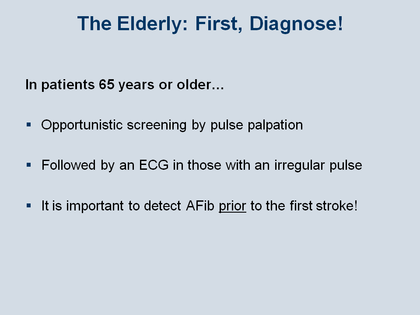William French, MD - Anticoagulation: Special Populations - Figure 6
The Elderly: First, Diagnose!
What explains this failure to apply anticoagulation therapy in AFib patients? In the author’s experience teaching many house officers and cardiology fellows in clinical practice and in consultations with primary care physicians, it is surprising to note how often physicians overlook a very simple aspect of this most common arrhythmia in clinical practice, namely, making the diagnosis. Without the diagnosis of AFib, clinicians are obviously not going to be able to prescribe the correct therapy.
How to optimize diagnosis of AFib? As shown in the Figure, an important consistent first step is to ensure that someone is actually taking the opportunity to do a simple screening process by feeling the patient’s pulse.
If the patient’s pulse is irregular, then the physician needs to do an electrocardiogram (ECG). This is the simplest, most direct way of diagnosing AFib, and it is really inexcusable that patients might be coming for regular visits to the office or clinic and no one is recognizing a patient’s new-onset AFib. The only way to ensure this is to establish a procedure whereby when the patient’s vital signs are taken, the pulse is taken as a screening tool to ensure that in those who have a regular pulse versus those who have an irregular pulse, the appropriate ECG is taken to diagnose the possible presence of AFib.
Thus a very simple procedure and tool can be used to increase the number of patients who are recognized as having probable new-onset AFib – although doctors should realize that if the pulse has not been palpitated for a long time, it may be that they are diagnosing AFib that has been present for a long time.
French WJ. Am J Med 2013; 126: 00-00.

